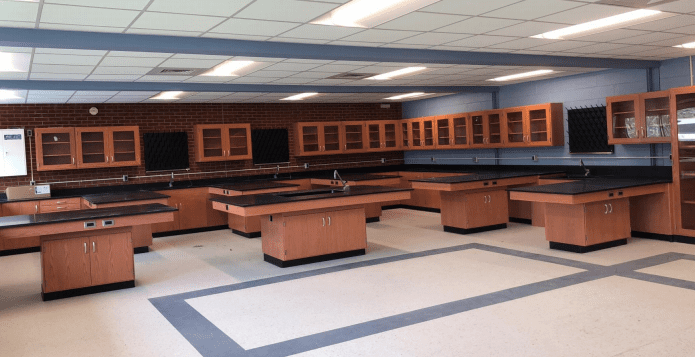Students can safely take a deep breath while attending classes in the newly reopened K-Wing of Northport Middle School.
Northport-East Northport school district has reopened the K-Wing of Northport Middle School for student and staff use after environmental testing for volatile organic compounds conducted by consultants J.C. Broderick & Associates Aug. 27 determined it was safe for use. The study and its conclusions were reviewed by officials in New York State’s Department of Health.
“[T]he levels of volatile organic compounds detected at the time of the sampling are well below any levels that have been associated with adverse health effects.”
— Michael Hughes
“Based on the air concentrations and information presented in the report, the levels of volatile organic compounds detected at the time of the sampling are well below any levels that have been associated with adverse health effects,” wrote Michael Hughes, a section chief in the state’s Bureau of Toxic Substance Assessment, in a Sept. 4 email. “The NYSDOH therefore concurs with the conclusion in the report that staff and students occupy the K-Wing in the school.”
On Aug. 27, J.C. Broderick & Associates staff conducted volatile organic compound, or VOC, sampling in K-Wing classrooms to determine if extensive summer renovations had resolved indoor air quality concerns. The district had closed off the area for the 2017-18 school year after an earth science teacher reported smelling gasoline fumes and an investigation found the source to be a petroleum-based warehouse beneath the K-wing.
The testing was performed using 26 cannisters, according to J.C. Broderick & Associates — two in each of the classrooms, the hallway and underground warehouse to test for any hazardous airborne chemicals. The samples were then sent to York Analytical Laboratories to be analyzed and compared against five sets of guidelines.
“In the report, there were a couple of VOCs that were detected,” Superintendent Robert Banzer said at the Sept. 6 board of education meeting.
The first chemical, methyl methacrylate, was measured at 1.4 to 5.1 micrograms per cubic meter of air in four classrooms, both hallway samples and the warehouse. These levels exceed New York State Department of Health’s 95th percentile concentration of 1.1 micrograms per cubic meter based on the average found in roughly 100 Albany residential homes . The environmental experts used safety data sheets, which list any potentially chemicals found in various products used, to determine it was coming off floor wax applied to the new flooring surfaces in the K-wing.
“The sampling performed did not identify any hazardous concentrations of VOC parameters in any of the sampled locations when compared with the above referenced health-based values.”
— J.C. Broderick & Associates report
The second chemical, Styrene, was measured at 20 to 27 micrograms per cubic meter of air in the warehouse only, above the 2.3 micrograms per cubic meter of air set as the 95th percentile by the state Department of Health. The data sheets showed it was notably found in the shrink-wrap used to wrap pallet products stored in area.
Once these two chemicals were found to be above the 95th percentage, J.C. Broderick & Associates report compared its findings to four health-based guidelines, the most stringent being the U.S. Environmental Protection Agency’s Reference Dose Concentration. The EPA’s guidelines provide an estimate of the maximum level of a VOC that can be continuously inhaled for a lifetime before adverse effects are seen and contains built in safety factors to protect sensitive groups, such as young children or the elderly.
“The sampling performed did not identify any hazardous concentrations of VOC parameters in any of the sampled locations when compared with the above referenced health-based values,” reads J.C. Broderick & Associates’ Aug. 31 report.
The methyl methacrylate found at 1.4 to 5.1 micrograms is well below the 700 micrograms per cubic meter guideline set by the EPA, as was styrene’s 27 micrograms under the 1,000-microgram limit.
Any concerned parent or staff member can find the full results of the air sampling reports and related correspondence on the district’s website at northport.k12.ny.us/district/bg_northport_ms_information.





